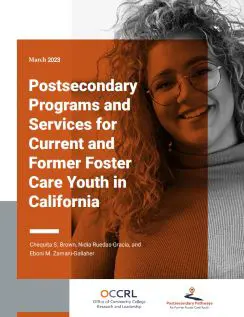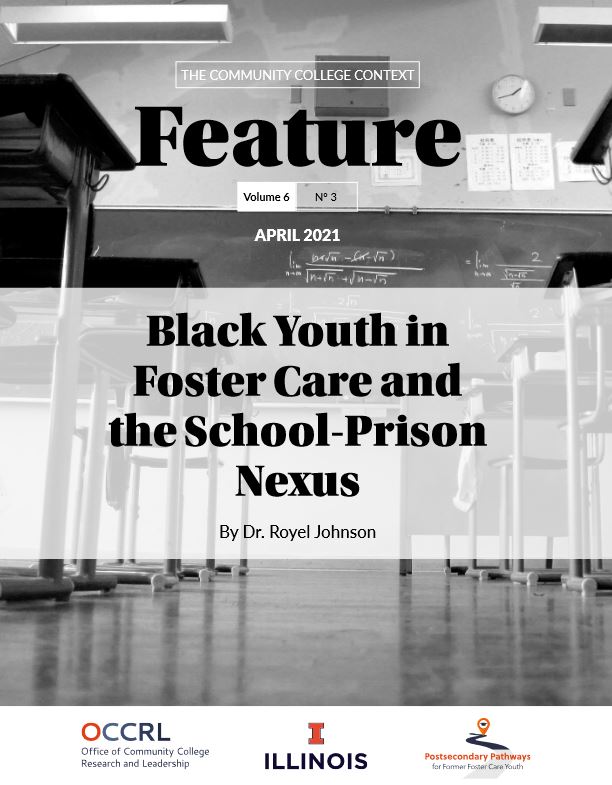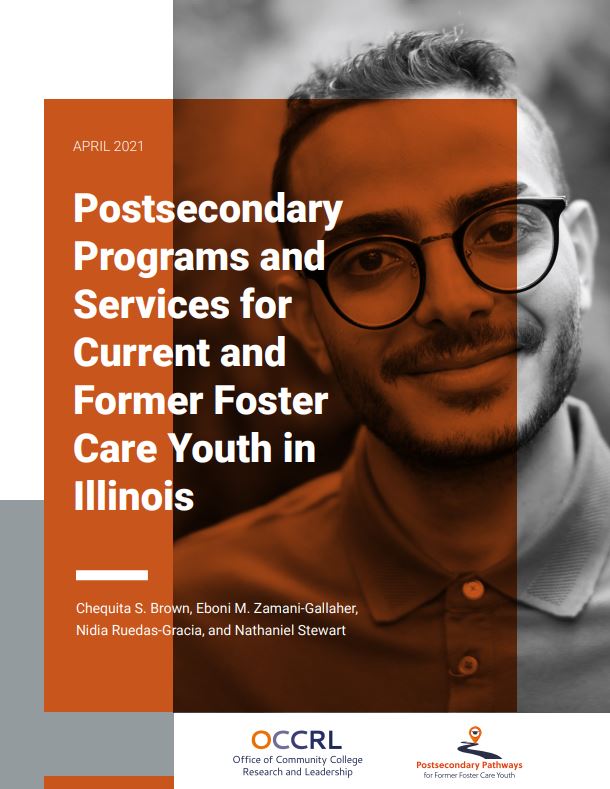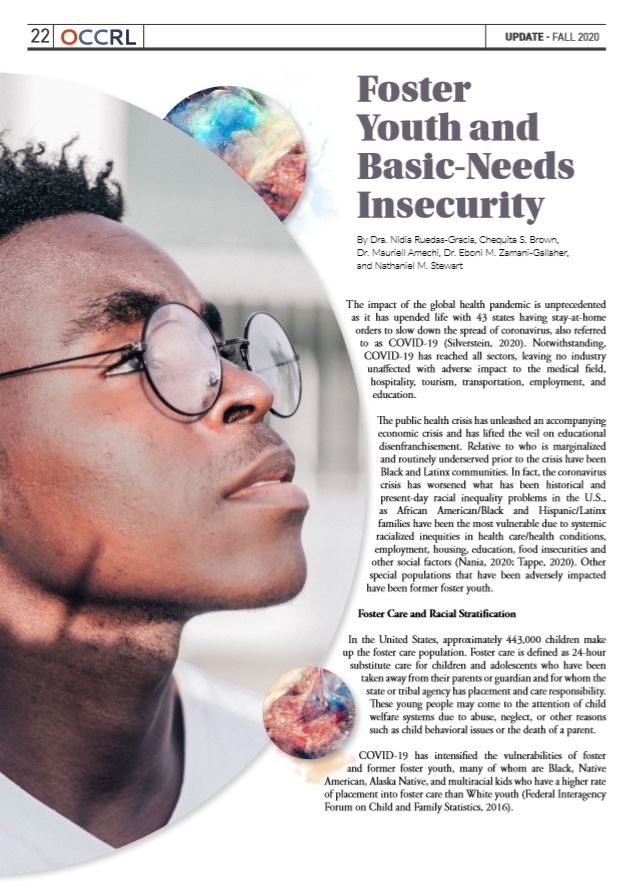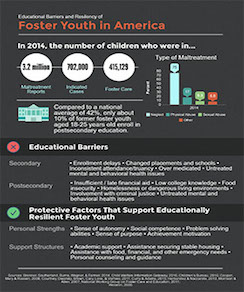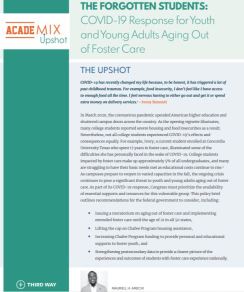Summary
The Postsecondary Pathways for Former Foster Care Youth (PP-FFCY) reflects OCCRL’s commitment to examining and developing postsecondary pathways that support mobility for first-generation, underserved, and minoritized populations, as well as strengthening career pathways to promote seamless transitions from college to careers. This project endeavors to examine postsecondary access, opportunities, and supports for foster youth in Illinois and other states across the county in addressing access and outcomes of FFCY in Career Technical Education (CTE).
Purpose
The Postsecondary Education Pathways for Former Foster Care Youth (PP-FFCY) project is an exploratory study focused on postsecondary pathways for current and former foster youth in Illinois. OCCRL is conducting a comprehensive-needs assessment that provides a descriptive profile of current and former foster youth populations in Illinois; examines postsecondary access, opportunities, and supports for foster youth in Illinois; and addresses disparities in career and technical education (CTE) programs. This project reflects OCCRL’s commitment to examining and developing postsecondary pathways that support mobility for first-generation, underserved, and minoritized populations as well as strengthening and supporting career pathways to promote seamless transitions from college to careers.
Resources
OCCRL aims to increase postsecondary awareness, access, and attainment for current and former foster care youth by providing information on programs and other resources that offer holistic support and services. View the list of postsecondary programs and services.
Podcasts
Strategies to Cultivate a Foster-Friendly Culture on Community College Campuses
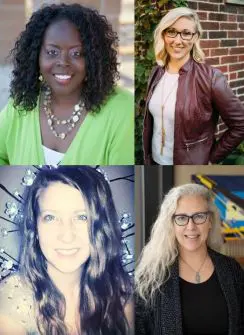 In this episode, Chequita Brown talks with Kate Danielson of the organization Foster Progress, as well as with Anna Wandtke and Tricia Wagner of Rock Valley College in Rockford, Illinois. The group discusses how to cultivate a foster-friendly culture at Illinois community colleges.
In this episode, Chequita Brown talks with Kate Danielson of the organization Foster Progress, as well as with Anna Wandtke and Tricia Wagner of Rock Valley College in Rockford, Illinois. The group discusses how to cultivate a foster-friendly culture at Illinois community colleges.
Navigating College as a Foster Care Alum
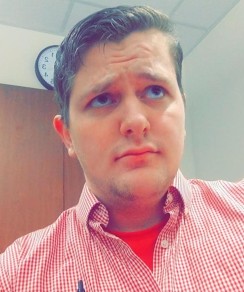 In this episode, OCCRL research assistant Chequita S. Brown talks with Jonathan Stacy, a sophomore at Heartland Community College who is pursuing his studies and a possible career in criminal justice.
In this episode, OCCRL research assistant Chequita S. Brown talks with Jonathan Stacy, a sophomore at Heartland Community College who is pursuing his studies and a possible career in criminal justice.
Listen to the podcast and view the transcript.
Key Elements to Successfully Connecting Foster Care Youth to Educational Resources for Postsecondary Success
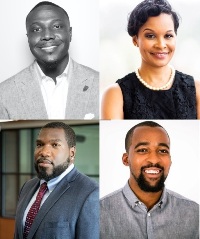 In this episode, Nathaniel Stewart talks with Mauriell Amechi, Regina Gavin Williams, and Blayne Stone Jr. about how the transitions and pathways to postsecondary education are similar and different for Black former foster care students. The scholars also discuss key elements to successfully connect foster care youth to educational resources that help advance the postsecondary education opportunities for this student population.
In this episode, Nathaniel Stewart talks with Mauriell Amechi, Regina Gavin Williams, and Blayne Stone Jr. about how the transitions and pathways to postsecondary education are similar and different for Black former foster care students. The scholars also discuss key elements to successfully connect foster care youth to educational resources that help advance the postsecondary education opportunities for this student population.
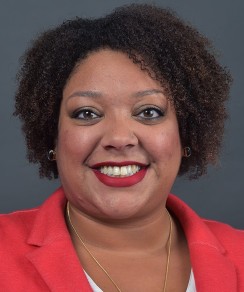
Maddy Day
The Impact of Campus-Based Support Programming on Foster Care Collegians' Postsecondary Access and Retention
In this episode, Chequita Brown of OCCRL talks with Maddy Day about the Fostering Success initiative in Michigan and the impact of campus-based support programming on foster carecollegians' postsecondary access and retention.

Patricia Palmer
How Youth-in-Care in Illinois Can Access Educational Resources to Pursue a Postsecondary Education
In this episode, OCCRL research assistant Chequita Brown continues the conversation on foster care youth by talking about with Patricia Palmer about accessing available resources in Illinois for youth-in-care who want to pursue a postsecondary education.
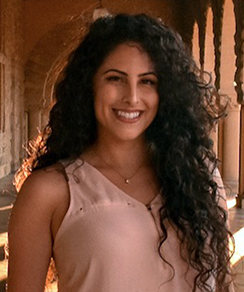
Nidia Ruedas-Gracia
Conceptualizing 'Sense of Belonging' Among Students From Historically Minoritized Racial Groups Within Higher Education
In this episode, Colvin Georges Jr., a research associate at OCCRL, talks with Dr. Nidia Ruedas-Gracia about what it means to have a sense of belonging and discusses her research in this area. They also discuss how a sense of belonging affects college students from historically minoritized racial groups.
Publications
Postsecondary Programs and Services for Current and Former Foster Care Youth in California
By Chequita S. Brown, Nidia Ruedas-Gracia, and Eboni M. Zamani-Gallaher
This brief highlights postsecondary programs and services in California that support youth in care, in addition to young adults who are aging out of foster care. Read more.
Tracking College-to-Career Pathways for Foster Youth
By Chequita S. Brown
In this OCCRL Thought Paper, Chequita S. Brown relates how tracking the data of students with foster care experience helps to recognize them as a legitimate student population. She offers recommendations on how to do this and conveys the many obstacles that can hinder the academic and career success of foster youth. Read more.
Black Youth in Foster and the School-Prison Nexus
By Royel Johnson
In this OCCRL Feature Brief, Dr. Royel Johnson argues that the foster care system, and more specifically congregate care facilities, are part and parcel to the enhancement of carceral state power. Read more.
Postsecondary Programs and Services for Current and Former Foster Care Youth in Illinois
By Chequita S. Brown, Eboni Zamani-Gallaher, Nidia Ruedas-Gracia, and Nathaniel M. Stewart
This research brief provides an overview of programs and services that helps strengthen postsecondary pathways for current and former foster youth in Illinois. Read more.
Foster Youth and Basic-Needs Insecurity
By Dra. Nidia Ruedas-Gracia, Chequita S. Brown, Dr. Mauriell Amechi, Dr. Eboni Zamani-Gallaher, and Nathaniel M. Stewart
This article discusses how COVID-19 has intensified the vulnerabilities of foster youth and former foster youth, many of whom are Black, Native American, Alaska Native, and multiracial children who have a higher rate of placement into foster care than White youth (Federal Interagency Forum on Child and Family Statistics, 2016). Read more.
(From the Fall 2020 UPDATE on Research and Leadership)
Exploring Equity in Postsecondary Education
By Heather L. Fox, Eboni M. Zamani-Gallaher
This chapter examines how postsecondary practitioners are encouraged to work collaboratively with child welfare agencies and other community-based organizations to identify and implement culturally responsive supports for former foster youth to promote early academic achievement. Read more.
The Forgotten Students: COVID-19 Response for Youth and Young Adults Aging Out of Foster Care
By Mauriell H. Amechi
This policy brief outlines recommendations for Congress to consider regarding the country's COVID-19 response, in an effort to prioritize the availability of essential supports and resources for youth and young adults who are aging out of foster care. Read more.
Voices and Viewpoints
Attending Community Colleges is a Big Decision: Supporting Foster Care Alum’s Postsecondary Choices and Transitions
Once again, it’s that time of the year when hundreds of thousands of high school seniors will receive numerous acceptance letters from postsecondary institutions nationwide—“I got in” is a repeated phrase by students expressing excitement over being wanted by a school of interest.
But despite the countless acceptance letters, it all comes down to one school, a choice typically made public on May 1 and recognized as National College Decision Day. Commemorating their school commitment, students posted images sporting paraphernalia representing their college of choice, accompanied by the trending hashtag #CollegeDecisionDay. Celebratory messages flooded social-media outlets with people congratulating high school seniors as they celebrated the end of an era and prepared for a new chapter as college students.
As an educator and scholar, I enjoy celebrating National College Decision Day, specifically when I am personally invested in supporting select students’ academic and career pathways. In the spirit of National College Decision Day, I purchased a school shirt for my mentee, Zaria, who recently finalized her college decision. Zaria, who is a foster care youth, had worked hard throughout her junior and senior years to improve her grades. Though she initially entertained the idea of attending a four-year institution, Zaria decided to start her college journey at Heartland Community College. I was extremely proud of Zaria’s commitment and eager to celebrate her college decision with a gift—a new T-shirt with her school’s name adorning it.
Yet Zaria’s reaction to her shirt was rather humdrum. Here’s what was said:
Zaria: “Thanks, but you don’t have to make a big deal about it. I’m just going to a community college.”
Gasping from the offense in her response and clutching my imaginary pearls, I responded, “First off, I need you to delete the word just because going to college—whether you attend a four-year or two-year institution—is a big deal. Plus, you decided to attend the community college. You could have enrolled in a four-year school, but you chose to start off at two-year school to ease into college life. I could be wrong, but it sounds like you made a smart choice based on your needs and experience. So, yes, it is a big deal and a decision we should celebrate.”
My encounter with Zaria led me to wonder how many other high school students have neglected to celebrate their postsecondary choice because it’s just a community college. Equally important, how have we—as educators, practitioners, school counselors, mentors, and parents—unintentionally illuminated the four-year college pathway to the point that it eclipsed the value and excitement associated with attending a two-year institution?
Too often, community colleges are an overlooked asset."
Too often, community colleges are an overlooked asset. The open-access mission of these institutions provides educational opportunities to students with varying academic levels and from diverse backgrounds. Students are offered developmental classes to strengthen basic competencies and academic skills that are foundational for the successful completion of college-level coursework (Bahr & Gross, 2016). Although taking developmental courses is known to delay graduation (Perin, 2005), having access to developmental courses is beneficial to students with foster care experience.
For students like Zaria, who struggled academically in high school, matriculating at a community college is a sound decision. Due to placement instability and disruptions in their educational progress, foster care high school graduates are likely grade repeaters due to poor academic performance and may have lower standardized exam scores, which often leaves them underprepared for college-level work (Dworsky, 2018; Piel, 2018; Watt, Norton, & Jones, 2013). Since students with foster care histories are likely to matriculate at a community college (Dworsky, 2018; Courtney et al., 2016), having access too developmental courses can positively improve their postsecondary outcomes (Chen, 2016).
Additionally, attending a community college is a financially sensible choice. Community colleges offer lower tuition rates and fees than four-year institutions, which makes them more affordable when striving for a college degree or for certificates (Dworksy, 2018; Hernandez & Naccarato, 2010). Recent data indicated tuition and fees at a public, community college were an average rate of $3,730 for full-time, compared to approximately $10,444 at a four-year, in-state college (AACC, 2020).
What’s more, community colleges provide promising pathways to career and upward mobility through career and technical education (CTE) programs. Depending on the field, CTE students who earn an associate’s degree or certificate can attain higher earning potential compared to a student with a bachelor’s degree (Carnevale, et al., 2020). Community college students with foster care experience can complete short-term, career-centered programs that provide academic and technical training to enhance professional skills for immediate employment following graduation (Carnevale, et al., 2020).
Also, deciding to enroll at a community college allows foster care alumni to ease into the college experience. Community colleges offer smaller campuses and classes, which allow students to connect with professors and other support staff while acclimating to campus. Given that community colleges are structured to accommodate the learning of both traditional and nontraditional students, these institutions commonly offer flexible course options and schedules during the evening, weekend, and online. This is beneficial for all students but even more so for individuals with foster care experience, since they may need to work while in college.
As campuses return to in-personal learning, it’s important to understand that support—whether personal or professional, on campus and in the community— is essential to foster care alumni academic and professional success. Unlike their non-foster care peers, foster care youth often lack familial connections to provide them with financial support while in college (Hallett & Westland, 2015). Once emancipated, foster youth must assume full responsibility for their self-care, which often requires foster youth to seek full-time employment. Though they may have college aspirations, establishing self-sufficiency may take precedence over going to college when transiting to adulthood. However, attending a community college, even as a part-time student, provides the opportunity to balance their academics goals alongside work and personal obligations.
Remember, National College Decision Day celebrates the choice of up-and-coming students to enroll in college and to take the next steps toward their transition to adulthood. It’s incumbent on us as educators and people who care about education to celebrate and support their decision. We can accomplish this by:
- Affirming their choice. Acknowledge their choice to attend college. Inquire about their academic interests (i.e., major) and career aspirations. The goal is to express interest and encourage their college and career plans.
- Actively supporting their choice. It is important to offer support to help students ease into their college lives. You can do this by sharing resources and information related to campus support systems. In addition, you can note essential tasks required of all new college students to ensure they are making progress during the transition from high school to college. For example, you may ask questions such as:
- Do you need help ordering your high school transcripts and sending them to a community college?
- Have you completed your FAFSA application?
- Have your received confirmation of your financial awards?
If the student hasn’t visited any campus yet, you may consider volunteering to accompany her or him on a campus visit or assisting with scheduling an academic advising appointment. These are just a few ways you can actively support a student’s choice to attend a community college.
In case you are wondering, Zaria’s attitude toward attending a community college eventually changed, which was inspired by a campus tour. As we walked the campus, Zari began to visualize herself as a college student. Learning about the campus resources and speaking with essential college personnel helped bolster Zaria’s anticipation for college life. Though nervous about the challenges she may encounter fall semester, Zaria’s decision is settled and she is excited about her college and career future.
Students with foster care experience often lack reliable adult support. Unlike their non-foster peers, foster youth often miss out on familial connections and social support that can help prepare them for adulthood and college life (Hallett & Westland, 2015; Wolanin, 2005). Your support and genuine excitement will help empower their decision to enroll at a community college and ease anxiety about transitioning to campus life.
This is your opportunity to show foster care alumni that choosing a community college for their postsecondary education is indeed a big deal.
References
AACC (American Association of Community Colleges). (2020, November). Fast facts 2021.
Bahr, P. R., & Gross, J. L. (2016). Community college. In M. Bastedo, P. Altbach, & P. Gumport (Eds). American Higher Education in the 21st Century: Social, Political, and Economic Challenges (4th ed., pp. 462-502). Baltimore, MD: Johns Hopkins University Press.
Carnevale, A. P., Garcia, T. I., Ridley, N., & Quinn, M. C. (2020). The overlooked value of certificates and associate’s degrees: What students need to know before they go to college. Georgetown University Center on Education and the Workforce. https://cew.georgetown.edu/cew-reports/subba/
Chen, X. (2016). Remedial Course taking at U.S. Public 2- and 4-Year Institutions: Scope, Experiences, and Outcomes (NCES 2016-405). U.S. Department of Education. Washington, DC: National Center for Education Statistics. http://nces.ed.gov/pubsearch.
Courtney, M. E., Okpych, N. J., Charles, P., Mikell, D., Stevenson, B., Park, K., Kindle, B., Harty, J., & Feng, H. (2016). Findings from the California youth transitions to adulthood study (CalYOUTH): Conditions of youth at age 19. Chicago, IL: Chapin Hall at the University of Chicago. http://fosterreprohealth.org/wp-content/uploads/2018/04/Courtney-et-al-Findings-from-the-California-Youth-Transitions-to-Adulthood-Study-CalYOUTH-Conditions-of-Foster-Youth-at-Age-19-2016.pdf
Dworsky, A. D. (2018). Improving the postsecondary educational attainment of youth in foster care. New Directions for Community Colleges, 2018(181), 11-19. doi:10.1002/cc.20287
Hallett, R. E., & Westland, M. (2015). Foster youth: Supporting invisible students through visibility. About Campus, 20(3), 15-21. Doi:10.1002/abc.21194
Hernandez, L., & Naccarato, T. (2010). Scholarships and supports available to foster care alumni: A study of 12 programs across the US. Children and Youth Services Review, 32(5), 758–766. Doi:10.1016/j.childyouth.2010.01.014
Perin, D. (2005). Institutional decision making for increasing academic preparedness in community college. New Directions for Community College, 129, 27-38.
Piel, M. H. (2018). Challenges in the transition to higher education for foster care youth. New Directions for Community Colleges, 2018(181), 21-28. doi:10.1002/cc.20288
Watt, T. T., Norton, C. L., & Jones, C. (2013). Designing a campus support program for foster care alumni: Preliminary evidence for a strengths framework. Children and Youth Services Review, 35(9). 1408-1417.
Wolanin, T. R. (2005). Higher education opportunities for foster youth: A primer for policymakers. Washington, DC: The Institute for Higher Education Policy.




